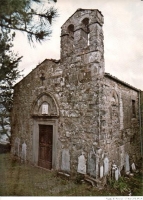Map
The Church of Saint Biagio

The plan of the church is rectangular, and the stone facade is a stone outline; on the right side, the building at the corner is surmounted by a bell gable.
Also interesting is the portal frames with sandstone of the mountain of the Appennino and the wooden door of chestnut score in four rectangular shaped panels, bolt with wrought iron and hand-chiselled triangular pendants (XVII century), with above archivolt ogive.
Inside is stoop (basin of holy water) a truncated pyramid, a square base and stem a column carved in stone, with circular baptismal font in white marble of the century. XVI and wrought iron frame, manufactured spiral reminiscent of the privilege enjoyed by this small church in the fourteenth century, among the first in the valley to get the coveted award.
There are also some graves of the XVI, XVII, XVIII, including epigraphs.
HISTORY
San Terenzio di Villa Roggiana (San Biagio del Poggio).
Not far from Poggio, in solitary position among fields and woods, stands the venerable church of San Biagio.
That small and charming building that reached value into Romanesque times with later alterations, is the document and the silent witness of the oldest religious and civic life of the area.
In the year 995, it looks like church with the title of Saint Terenzio of Villa Roggiana, and its territory extended from Careggine to Roggio and Poggio. The boundaries of religious jurisdiction supercharged probably the limits of an ancient Roman territory that had in that place the pagense center and this, in turn, limits an older conciliabulum, of the Apuan Ligurians.
The disappearance of the Byzantines, the center of Lombard Roggio assumed great value, high on the mountain, had its origin in an ancient pastoral center which later became the Roman praedium.
This important medieval castle that was his special fines, ie its political jurisdiction, had in Villa Roggiana, ie in the country, which was located at the Church, and which today has disappeared to a large landslide, and the Campus Rocianum that is, in today Camporgiano, the two great centers curtensi which integrated its pastoral economy.
A Roggio were reflected, Careggine in a demic similar position.
Both were in the parish seat of their trade and a meeting point of the trunk road in the valley.
Probably, the Parish of St. Terenzio, was built by the Byzantines around the first of 600, that is, before the church that we know Careggine_ founded in late 600 or early 700.
Also significant is the ancient dedication to St. Terenzio_ who was a pious bishop of Luni killed with any certainty from the Arian Lombards, during his work of evangelization in the interior of the diocese.
v But the cult of St. Biagio, who joins him and then takes over, is no less ancient and is due to the currents of Eastern monasticism. On the decline of military and political power, the caste of Roggio, the church loses its importance and in the thirteenth century is no longer church, but only chapel dependent on that of Fosciana.
The Poggio today is the inheritor of the great military center of Capriola, the Villa Roggiana and ancient church of San Terenzio.